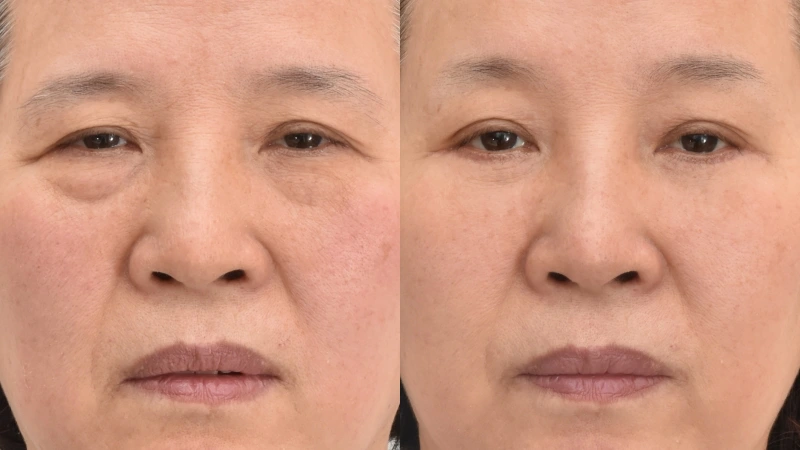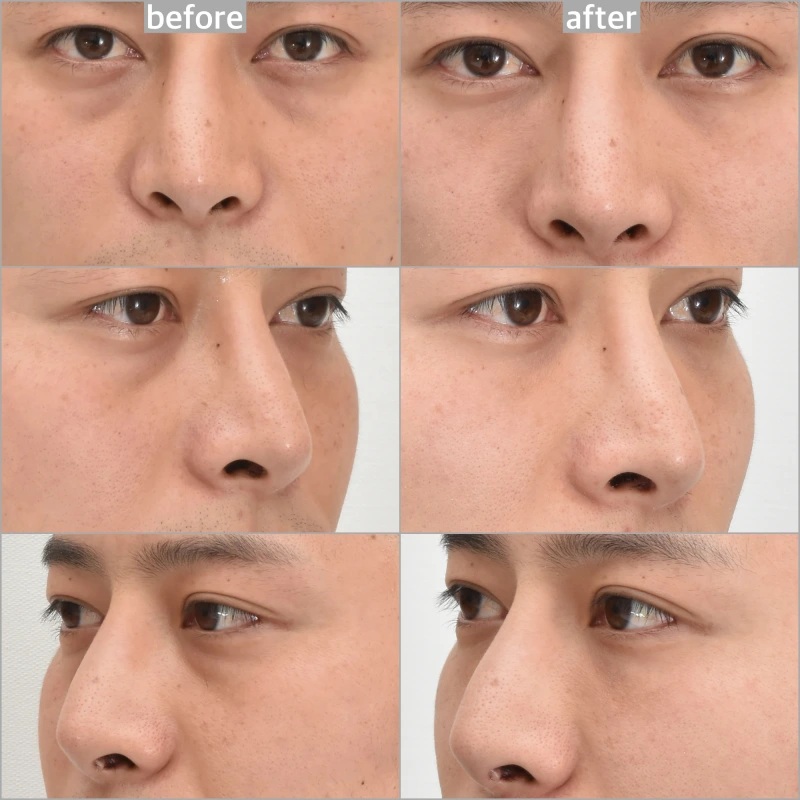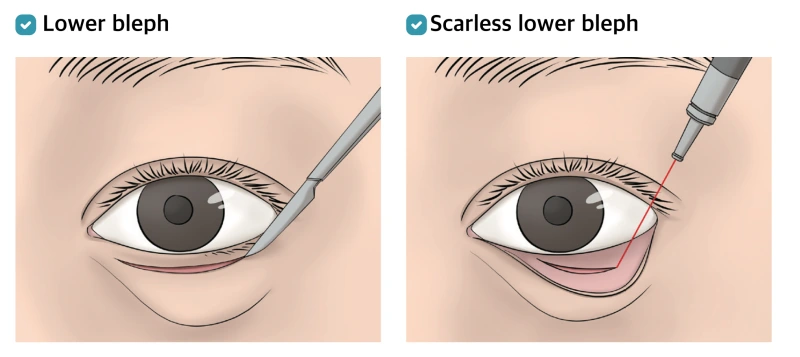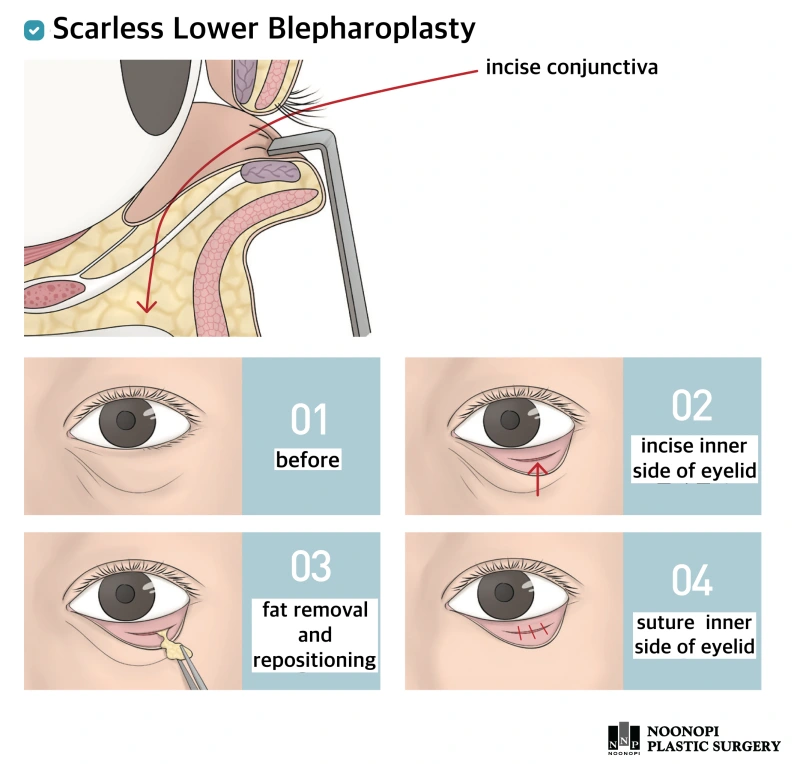To Incise or Not to Incise? That Is the Question: Rethinking Lower Eyelid Lift
2025-05-08
Thinking about a lower eyelid lift to get rid of under-eye bags and dark circles? This procedure can refresh your look and enhance your confidence. In this article, we’ll cover everything you need to know, including benefits, risks, and who is a good candidate.
Key Takeaways
- Lower eyelid lift surgery addresses aesthetic and functional issues of the lower eyelids, such as puffy eye bags and dark circles, primarily due to aging.
- Candidates for the procedure usually range from their late 20s to early 60s, possessing realistic expectations and good overall health, with the surgery performed through minimal scarring techniques.
- Post-surgery recovery typically involves managing swelling and bruising, with full recovery extending beyond a month, while results can last for 5 to 10 years, but are not permanent.
Understanding Lower Eyelid Lift Surgery

Lower eyelid lift surgery, or lower blepharoplasty, is a surgical procedure designed to rejuvenate the appearance of the lower eyelids. The primary goal is to restore eyelid function and improve aesthetics by addressing issues such as puffy eye bags, dark circles, crepey skin, and volume loss under the eyes. This procedure can involve the removal or repositioning of fat, as well as the tightening of excess skin to achieve a smoother and more youthful look. Cosmetic eyelid surgery can also be an option for those seeking similar results.
Aging is a common cause of under-eye issues, as it reduces skin elasticity and leads to the formation of bags under the eyes. But for less aged eyes, scarless method can work fine.

Causes of Under-Eye Bags and Dark Circles
Under-eye bags and dark circles can be attributed to a variety of factors:
- Aging: leads to thinning skin under the eyes, making blood vessels more visible and contributing to a darkened appearance.
- Genetics: if your family members have dark circles, you may be more likely to develop them as well.
- Lifestyle factors: lack of sleep, poor diet, and allergies can exacerbate the formation of bags under the eyes.
Several factors contribute to the appearance of dark circles under the eyes:
- Lack of sleep causes the skin beneath the eyes to appear paler, accentuating the visibility of blood vessels.
- High stress levels, excessive alcohol consumption, and smoking can further contribute to the formation of dark circles.
- Dehydration leads to a dull appearance of the under-eye area, emphasizing dark circles even more.
Individuals with lighter skin tones may find dark circles more noticeable, while those with darker skin tones may experience more pronounced circles due to increased melanin production. Fluid retention, excess fat, and the natural aging process all contribute to the appearance of under eye circles. Understanding these causes, including the effects of sun exposure, can help you take proactive steps to mitigate these issues.
Candidates for Lower Eyelid Lift
Lower eyelid lift surgery is suitable for a wide range of individuals, typically from their late 20s to early 60s, with most considering the surgery between their mid-30s and mid-50s. Ideal candidates often present with noticeable bags under the eyes, persistent dark circles, and wrinkled or sagging lower eyelid skin. These individuals seek not only cosmetic improvement but also a boost in their overall self-confidence.
Good candidates are usually:
- In overall good health
- Without severe chronic medical conditions
- Having realistic expectations of what the surgery can achieve
If you fall into this category and are troubled by under-eye issues, consulting with a qualified plastic surgeons oculoplastic surgeon can help determine if you are a suitable candidate for a lower eyelid lift to address lower eyelid laxity and tear trough deformity.
Techniques : Lower blepharoplasty vs Scarless method

| Lower blepharoplasty | Scarless lower blepharoplasty | |
| Strength | Also treat skin laxity, More fundamental rejuvenation | No skin incision, Short down time, Orbital muscles are preserved |
| Weakness | Risk of ectropion | Abundent skin can not be treated |
| Best for | Age over mid 40's | 30's or 40's with minimal skin laxity |
Lower eyelid lift surgery can be performed using different techniques, each tailored to the patient’s specific needs and the surgeon’s assessment. The two primary methods are the transconjunctival incision and the external incision techniques. The choice of technique depends on the pre-operative assessment, the patient’s desires, and the specific requirements for skin removal.
Scars from lower eyelid lift surgery are minimal and often barely noticeable after healing, resulting in a more aesthetically pleasing outcome.
Transconjunctival Incision Technique
The transconjunctival incision, also known as scarless method involves making a small incision inside the lower eyelid, avoiding any visible scars. This method is particularly beneficial for patients who do not require significant skin removal but need fat repositioning or removal to address puffiness and under-eye bags.
The transconjunctival approach minimizes visible scarring, offering a more discreet surgical outcome with quicker recovery and less postoperative bruising, making it a preferred option in reconstructive surgery for its aesthetic benefits and faster recovery.
External Incision Technique
The external incision technique involves making an incision just below the eyelashes on the lower eyelid. This approach allows for the effective removal or repositioning of excess fat to remove excess fat and tightening of sagging skin, addressing more severe cases of under-eye bags and wrinkles.
While this method may result in a small, barely noticeable scar, it is highly effective in achieving the desired aesthetic improvements. The external technique provides a comprehensive solution for patients requiring more extensive correction, including lateral canthopexy.
Pre-Operative Preparation
Proper pre-operative preparation ensures a successful lower eyelid lift surgery. An oculoplastic surgeon will assess your condition and guide you through essential steps for optimal results. One key preparation is to stop smoking and avoid nicotine products for at least four weeks before surgery to aid healing.
To prepare for surgery:
- Maintain a balanced diet, good nutrition, and a proper skincare routine weeks before surgery to enhance overall health and skin quality.
- The night before surgery, shower with antibacterial soap.
- Avoid cosmetics or styling products the night before surgery.
Wear loose-fitting clothing that can be easily removed on the day of surgery. Remove all nail polish, jewelry, and piercings, and arrange for a friend or family member to drive you home.
The Procedure

Lower eyelid lift surgery, also known as lower blepharoplasty, is a surgical procedure that can involve the upper eyelids, lower eyelids, or both. The procedure begins with incisions made in the natural creases of the eyelids, allowing the surgeon to remove excess skin and fat. This step is crucial in achieving a smooth and rejuvenated appearance through lower eyelid surgery.
After the removal of excess tissue, the surgeon uses small dissolvable stitches to secure the skin. A lower eyelid lift specifically removes bulging fat, repositions fat to fill hollow areas, and tightens the skin to smoothen fine wrinkles. An oculoplastic surgeon, who specializes in performing eyelid surgeries, plays a critical role in ensuring optimal aesthetic results, especially when addressing concerns like excess eyelid skin and removes excess skin.
Recovery Process and Timeline
The recovery process from lower eyelid lift surgery is generally straightforward. Patients can expect some swelling and bruising, minimal pain, and the ability to engage in light activities. Most minor complications, such as bruising and swelling, resolve without intervention.
Although excessive swelling can occur, it usually diminishes over time with proper care.
Immediate Post-Surgery Care
Immediately after surgery, fill any necessary prescriptions for pain medication and schedule time off work for proper recovery. Assistance on the day of surgery is crucial to follow post-operative guidelines effectively.
Keeping the head elevated significantly aids in reducing swelling and bruising.
Managing Swelling and Bruising
Swelling and bruising in the upper and lower lids are common symptoms after eyelid surgery. To help reduce swelling and aid recovery, you can:
- Use ice packs to reduce swelling.
- Elevate the head to speed up recovery.
- Apply warm compresses during the first week to alleviate skin itching and swelling.
The transconjunctival approach reduces recovery time and postoperative bruising.
Long-Term Healing and Activity Resumption
Patients should:
- Avoid strenuous activities and heavy lifting for at least two weeks to aid recovery days after surgery.
- Expect a decrease in bruising and swelling by the two-week mark.
- Understand that full recovery may extend beyond a month.
By weeks four to six, most patients can resume their regular exercise routines, following their surgeon’s advice. Downtime after a lower eyelid lift is usually 5–10 days for swelling and bruising.
Potential Complications and Side Effects
Like any surgical procedure, a lower eyelid lift comes with potential complications and side effects. Common side effects include dry eyes, watery eyes, and blurred vision. Patients may also experience vision changes or double vision, which usually improve within a short period. Infections can occur post-surgery, but timely treatment typically leads to resolution.
Complete healing after blepharoplasty can take up to a year or more, with scars continuing to improve over time. Dry eyes are a common side effect, and patients are often advised on moisturizing treatments to alleviate this.
Longevity of Results
The results of lower eyelid lift surgery are long-lasting but not permanent. Aging and changes in skin elasticity and underlying fat can affect the results over time. However, the surgery provides significant aesthetic and functional benefits, improving overall appearance and self-confidence.
Most patients enjoy the benefits of a lower eyelid lift for 5 to 10+ years, while non-surgical treatments like fillers last only 6 to 12 months. The durability of the results can be influenced by factors such as genetics and environmental exposure.
Treatment Options for Under-Eye Issues
Lower eyelid lift surgery is one of several treatment options for under-eye issues. Non-surgical treatments like laser resurfacing, chemical peels, and fillers can also improve the appearance of under-eye puffiness. Fillers, for instance, can be injected into the under-eye area to enhance volume and reduce hollowness.
Blepharoplasty can be performed in conjunction with other cosmetic blepharoplasty procedures like brow lifts or facelifts to achieve more comprehensive aesthetic results. Healthy lifestyle choices, such as a balanced diet and sun protection, significantly influence the duration of the blepharoplasty procedure results.
Summary
Lower eyelid lift surgery offers a viable solution for those struggling with under-eye bags, dark circles, and sagging skin. The procedure can significantly enhance your appearance and boost your confidence. If you’re considering this surgery, understanding the techniques, preparation, recovery, and potential complications will help you make an informed decision. Ultimately, consulting with a qualified Korean plastic surgeon is essential to achieving the best results.
